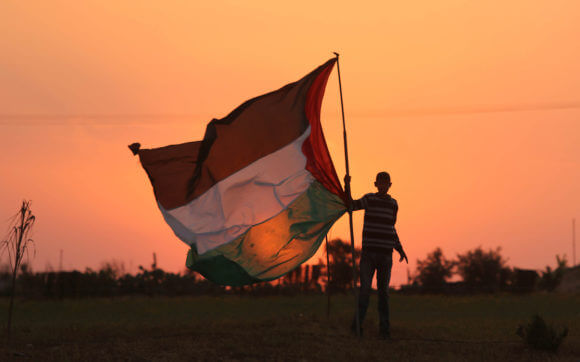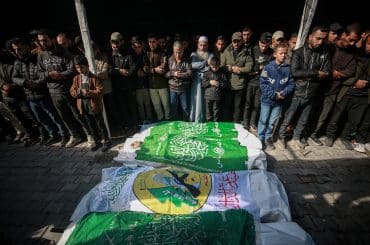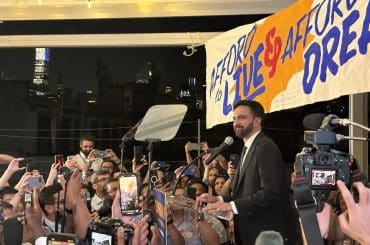In this article I’m going to reflect on what it has meant to cover the Great March of Return for the last year as a journalist, and not as much as a young Palestinian living in one of the refugee camps in the Gaza Strip, because the Israeli military expelled my family in 1948 from the village of Majdal-Asqalan.
This weekend is the first anniversary of the ongoing Great March of Return, which is considered the longest popular protest movement of the Palestinian people in the Gaza Strip in decades.
After covering nearly 50 Fridays over the past year, I can’t be more grateful that I’m still alive and did not suffer a serious injury.

During the last year I interviewed dozens of Palestinian refugees, academics, and politicians about the Great March of Return. I documented many alleged Israeli crimes against humanity, particularly those targeting children. At least 50 have been killed and almost 6,000 injured in the context of demonstrations in Gaza since last March, according to the United Nations Office for the Coordination of Humanitarian Affairs.
During the early days of coverage, I used to wear a PRESS vest. I believed that Israeli soldiers would avoid targeting me as journalist because media workers are protected by international law. During the first week of the march when some journalists were injured, I thought that it was either a coincidence or the result of the Israeli forces haphazardly shooting at demonstrators. However, I knew I was wrong when an Israeli soldier shot and killed the journalist Yasser Murtaja while he covered the second Friday of the marches, and Ahmad Abu Hussein, who was shot while working the following week. I felt then that journalists were being deliberately targeted.
After these events, I stopped wearing my PRESS vest and started to say goodbye to my mother, wife, and my then 5-month-old child every Friday on my way to cover the protests.
In the past, I used to think that I had a strong heart but when I would head out to cover the protests my heart never stopped beating fast, and this would continue for the entire time I was there and last for long after.
One of the things I never told anyone was that death or never seeing my family again wasn’t my biggest fear in the first place, but I was always afraid of being injured and made disabled. According to the Ministry of Health there have are over 120 amputees in the last year related to the protests.
Another secret is that I would stay away from my media colleagues during the protests, as I believe we’re targets. Once, I heard one of the young men in the march saying to his friend: “be careful, don’t stand near journalists so that we’re not targeted.”
In a recent statistic released by the Ministry of Health, the spokesman Ashraf al-Qedra stated that since the launch of the march, 115 journalists were injured and two were killed. Potentially Israel violated international law that provides protection to journalists working in conflict zones.
Black Monday
May 14th, 2018, this day was a black day for all Gazans when Israeli soldiers killed at least 59 people including 8 children and injured more than 2,700 people. I’ve covered the third war on Gaza and documented many massacres, but this day was like being in hell and its memories are still consuming me until today.
On the morning of that day, I had a fight with my wife to not go to the border area. Despite her crying I took my bag and left.
It was the first time I went early in the morning to the border area, specifically to the Malaka area east of the al-Zaytoun neighborhood, one of the central areas of the demonstrations. The atmosphere was normal as the crowds of demonstrators began to fill in, with armed Israeli soldiers hiding behind the sand dunes with their military vehicles near the border fence. Palestinian youth were exclaiming, women were sitting in tents, and speakers were everywhere. Everything was normal until noon.
The crowds began to approach gradually towards the fence; the scene was a sight I had not seen before since the beginning of the march and suddenly the Israeli soldiers started to shoot from at the peaceful demonstrators, dozens dropped as if a bomb had exploded.
At that moment I was 100 meters away from the fence, I was frozen in my place and tears started to fall out of weakness as I stood in front of the few Israeli soldiers who could stop the crowds in seconds if they decided to open fire.
The most difficult moments in covering the Great March of Return is when you feel and see the danger, and have no safe place to protect yourself.
Has it been worth it?
I still insist to share my opinion as a journalist, and not as a refugee demanding the right of return like other Palestinians who sacrificed their lives and beloved ones to achieve this dream.
Despite all the sacrifices, I believe that the Great March of Return is the beginning of victory over the occupation project of the Palestinian land. All sectors of people in Gaza have participated and are still participating in the demonstrations demanding their right of return and showing Israel and the world that this right can’t be negotiated.
The march has enhanced the principles and values of peaceful resistance with the public, helped put the Palestinian cause at the top of the international agenda, and increased awareness of the right of return. Besides, it gave a different picture about the occupation and boosted the world’s sympathy with Palestinians. But this media success is not enough compared to the sacrifices Gazans provided during the year; where at least 271 have been killed and over 28,000 were injured.
The march initially mobilized behind a slogan of peaceful protests, and organizers should work in a way that can decreases the casualties as much as possible.
In my view, the organizers of the march set their objectives without carefully considering the regional situation where Arab countries are busy with their own internal conflicts and at the same time some are normalizing relations Israel. The Great March of Return in Gaza cannot alone push towards national freedom unless it is supported by other actors, and has regional backing.
The political analyst Hussam al-Dajani, a professor of political science at Gaza’s al-Ummah University, agreed, “The dilemma of the Great March of Return is its timing and geographical limitations. If the Arab countries were not busy with their own conflicts and supported the march that would have made a difference. In addition, there’s no movement by other actors the region like the West Bank or Palestinian refugees camps in Jordan, Syria, and Lebanon.”
Another failure by the organizers is their inability, until now, to prosecute Israel in international courts. For example there has still not been a case condemning Israel in an international court for the black Monday massacre.
Most importantly, the organizers have failed until now to prevent demonstrators from getting close too the border fence. If they have been kept at bay, I believe that would have limited the number of serious injuries.
In summary, the Great March of Return didn’t achieve its announced results yet, it neither broke the siege nor returned the occupied lands, but did it fail? I believe it’s fair to call it a partial failure in light of some successes. As a journalist and refugee from Ashkelon, I will keep calling for the Palestinian right of return, requesting the people in charge use this march to benefit all Palestinians and identify a more realistic and well-studied goal, especially considering to the heavy physical toll protesters have incurred.
Updated: March 31, 2019 2:15 p.m.


